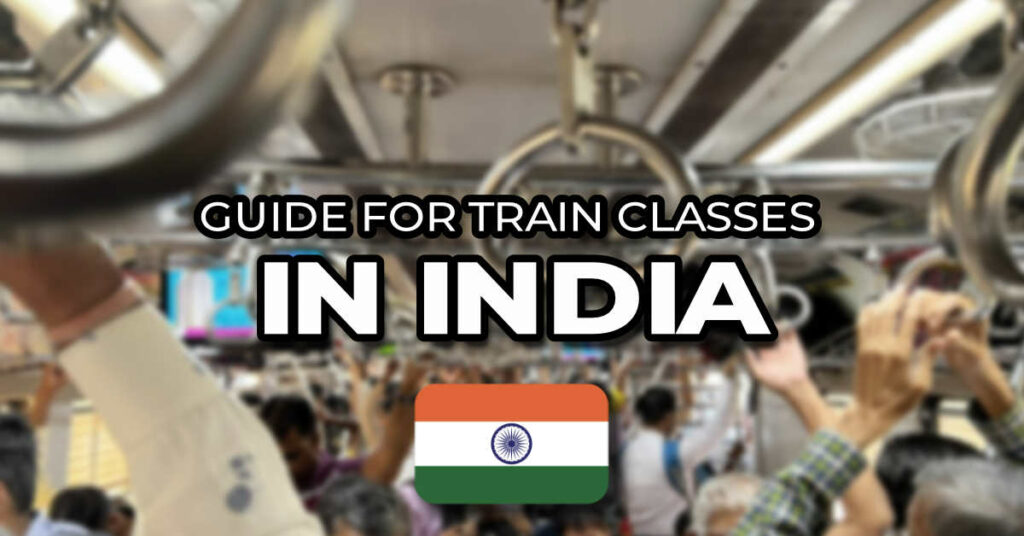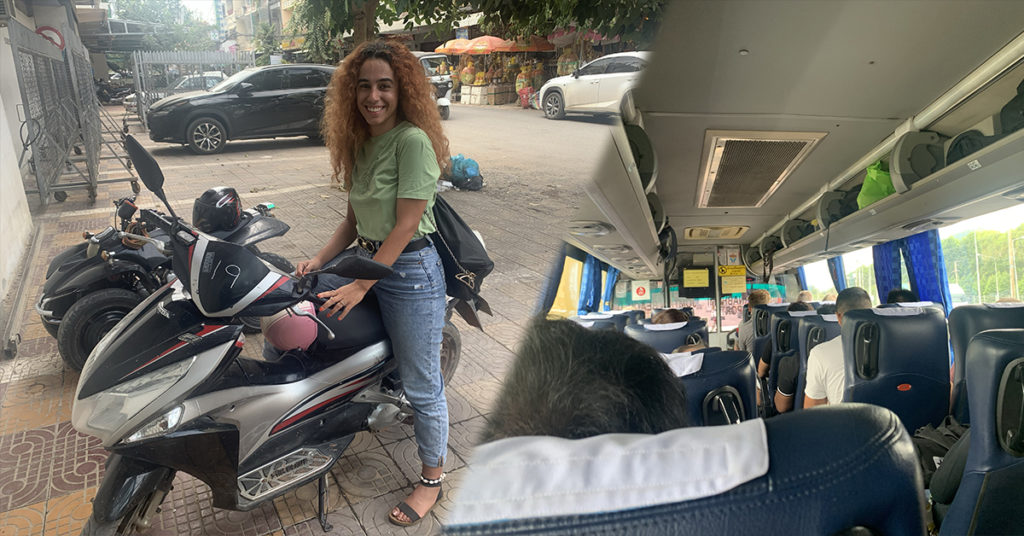When travelling on Indian trains, choosing the right class is key to a comfortable and safe travelling experience – your journey can be an unforgettable adventure or a nightmarish experience depending on just that one factor. In this guide, I’ll take you through all the class options, give you insights into what they offer, and help you make an informed choice that aligns with your travel style and preferences. Whether you’re a budget-conscious backpacker or a luxury lover, this guide will help you find the right train class for you.
Types of Classes in India
Quick overview of all train classes in India:
- Unreserved General Class (UR/GS): The most basic and cheapest option, often overcrowded with minimal comfort. Suitable for very short journeys, but not recommended for longer travel due to discomfort and safety concerns.
- Second Seating (2S): A step above UR/GS, offering slightly more comfort with cushioned benches. Affordable and suitable for short journeys, but lacks amenities like air conditioning.
- Air Conditioned Chair Car (CC): A comfortable option for short intercity travels, featuring reclining chairs, air conditioning, and included meals. Pricier than 2S but offers a significant upgrade in comfort.
- Executive Chair Class (EC): A luxurious version of the CC class, with more spacious and comfortable reclining seats, ideal for short, premium journeys. Includes meals and air conditioning.
- Anubhuti Class: The most luxurious among the non-sleeper classes, akin to business class in trains. Offers high comfort, excellent food, and is ideal for business travelers on shorter routes.
- Sleeper Class (SL): The most affordable option for overnight travel, providing beds but with minimal amenities. Often overcrowded and lacks air conditioning, suitable for budget travelers.
- Three Tier Air Conditioned Class (3A): A more comfortable and cleaner option than SL, with air conditioning and included bedding. Offers a balance of affordability and comfort for longer journeys.
- Two Tier Air Conditioned Class (2AC): Offers more space and privacy than 3A, with fewer beds per compartment and added amenities like privacy curtains and reading lights. Ideal for those seeking comfort at a reasonable price.
- First Class Air Conditioned (1AC): The epitome of luxury in Indian train travel, with spacious compartments, lockable doors, exclusive food menus, and shower facilities. Comparable to a high-end hotel room on rails, suitable for travelers seeking utmost comfort and privacy.
India’s trains have plenty of choices, and all of them are worlds apart from each other. Whether you want a real local experience or just a fancy ride with stunning views, Indian Railways has it all. But which one is right for you? These are your options.
Unreserved General Class (UR/GS)
Budget: Incredibly cheap, fares can start as low as INR 5 ($0.06) in a suburban local train, like the one I took in Mumbai.
Comfort: It’s very uncomfortable with benches made out of wood or plastic, and so crowded that you’d often struggle to even stand properly, let alone get a seat.
Privacy: Non-existent
Safety: It’s not very safe, and pickpocketing isn’t uncommon.
Journey duration: Better to completely avoid this class, for both long and short journeys.
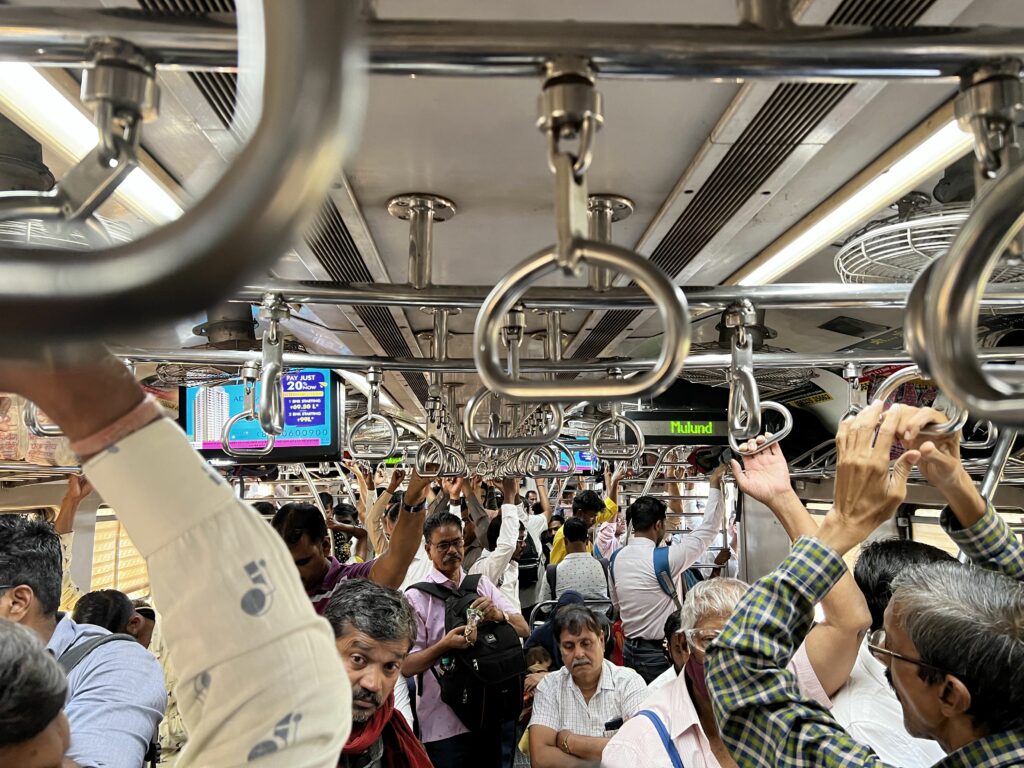
The General Class on the Mumbai Train
The Unreserved General Class is definitely the one you’d want to avoid as a general rule, especially for longer journeys. Most of the seats here are simple wooden benches and incredibly uncomfortable, and that is if you get a seat. Because of how crowded these sections can get, you probably won’t be able to experience those, as Indian trains are notorious for how packed they can get. You shouldn’t be surprised to find people sleeping on the floor, eating, or doing one of countless other things you’d not expect to find there.
Sometimes, you might not find a place to stand, as people here love to sit on the floor instead of standing. It’s by far the cheapest travel class in the Indian Railways, and mostly gets used by India’s poorest people, or by those who haven’t been able to secure a ticket to the sleeper class. I’ve personally travelled in one of the General classes in the local trains of Mumbai, and yes, it’s as packed and crowded as you’ve heard in the stories. I’ve also found myself travelling in the train during the rush hour, with people hanging out of the doors in order to get a place on their long journey back home. I’d urge you to not take this class, as I’m pretty sure you’d regret it later.
Video of Harry (the site owner) getting the unreserved General Class in North India
Second Seating (2S)
Budget: Very cheap. You can travel from Delhi to Lucknow for as low as INR 175 ($2.1), which is a ten-hour journey.
Comfort: Still not very comfortable, but better than the UR class. Seats have some cushion. Keep in mind that it can still be quite crowded and there is no AC.
Privacy: Non-existent
Safety: Pickpocketing is a risk, but other than that, relatively safe.
Journey duration: Suitable for shorter journeys, best to avoid for long travels.
Recommended for: Short train journeys on a tight budget, or for those that want to experience the local way of travelling by train without the raw experience of the unreserved class.
To travel in the Second Seating class, you’ll need to get a reservation, making it a slightly better option than the one above. It’s a bit less crowded, though you’d still encounter a few folks that didn’t get a reservation travelling here.
2S is often found on daytime intercity trains, and is the most budget-friendly option out of the other reservation classes. It’s mainly benches with some cushion, although some of the newer carriages also offer individual non-recliner seats. You can expect mild cooling options like fans. It’s a good option for those travelling short distances on a budget. However, I wouldn’t recommend opting for this class when taking a longer journey, as it’s not that comfortable.
Air Conditioned Chair Car (CC)
Budget: Much pricier than the above options, but for good reasons. For a train journey of one hour and forty minutes from Delhi to Agra, you’d pay around INR 755 ($9.07), including a meal.
Comfort: Comfortable, soft chairs that can recline, and you can keep your luggage in the overhead luggage space.
Includes: Food and AC.
Privacy: There is not much privacy, though it’s a class only for shorter journeys.
Safety: Relatively safer than the options above.
Journey duration: Suitable for short journeys between bigger cities.
Recommended for: Travelers looking to hop between cities that are okay with spending a bit more for extra comfort and safety.
The Air Conditioned Chair Car class is most commonly found on shorter distances. These trains mainly connect the bigger cities and towns with each other. This class is slightly more crowded compared to the Executive Chair class. It has three seats on one side, and two on the other side of the aisle. The seats can recline, with overhead space to keep your luggage. You’d have plenty of legroom, and a small foldable table attached to the seat in front of you. Meals are usually included in the fare.
Executive Chair Class (EC)
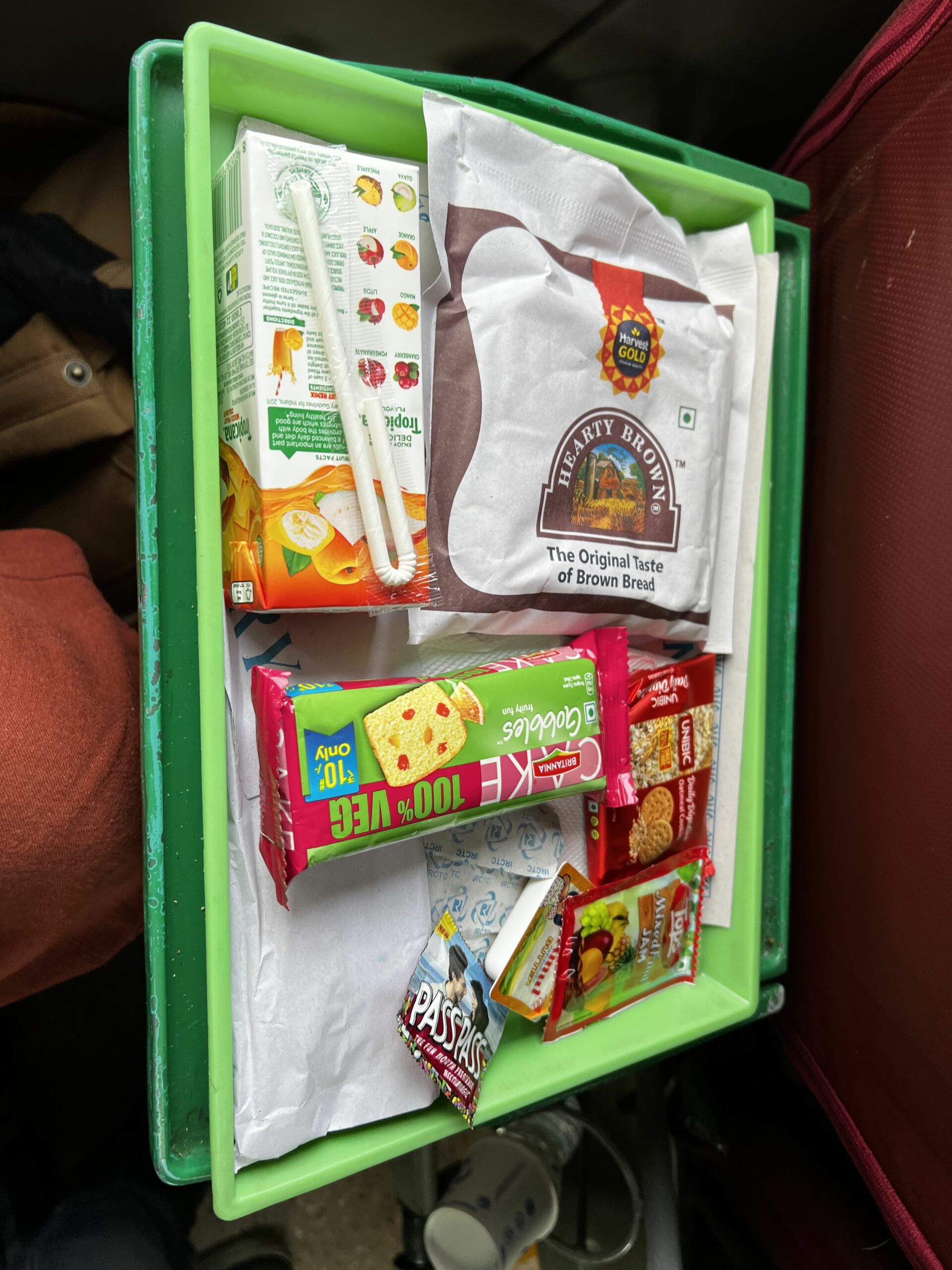
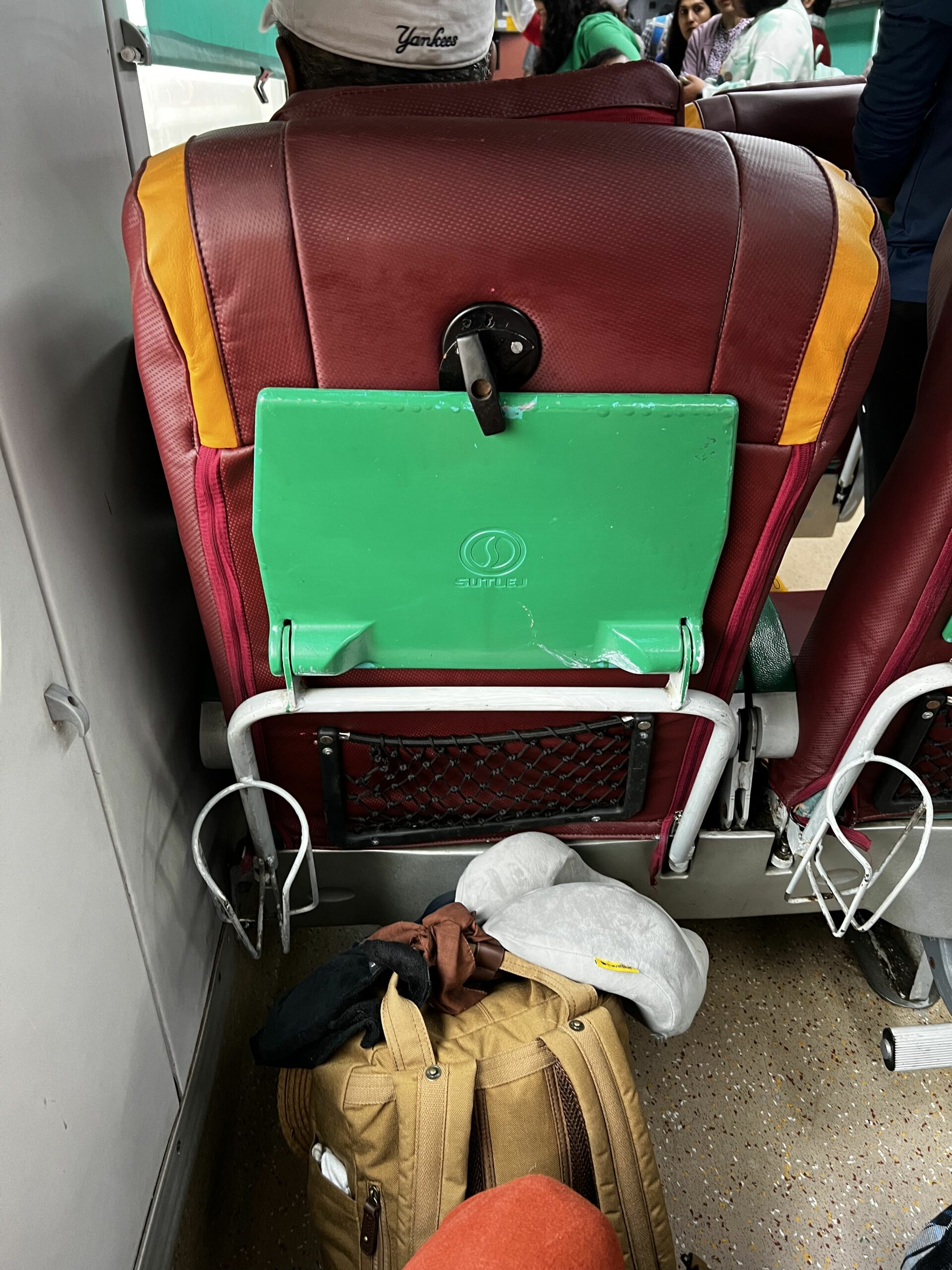
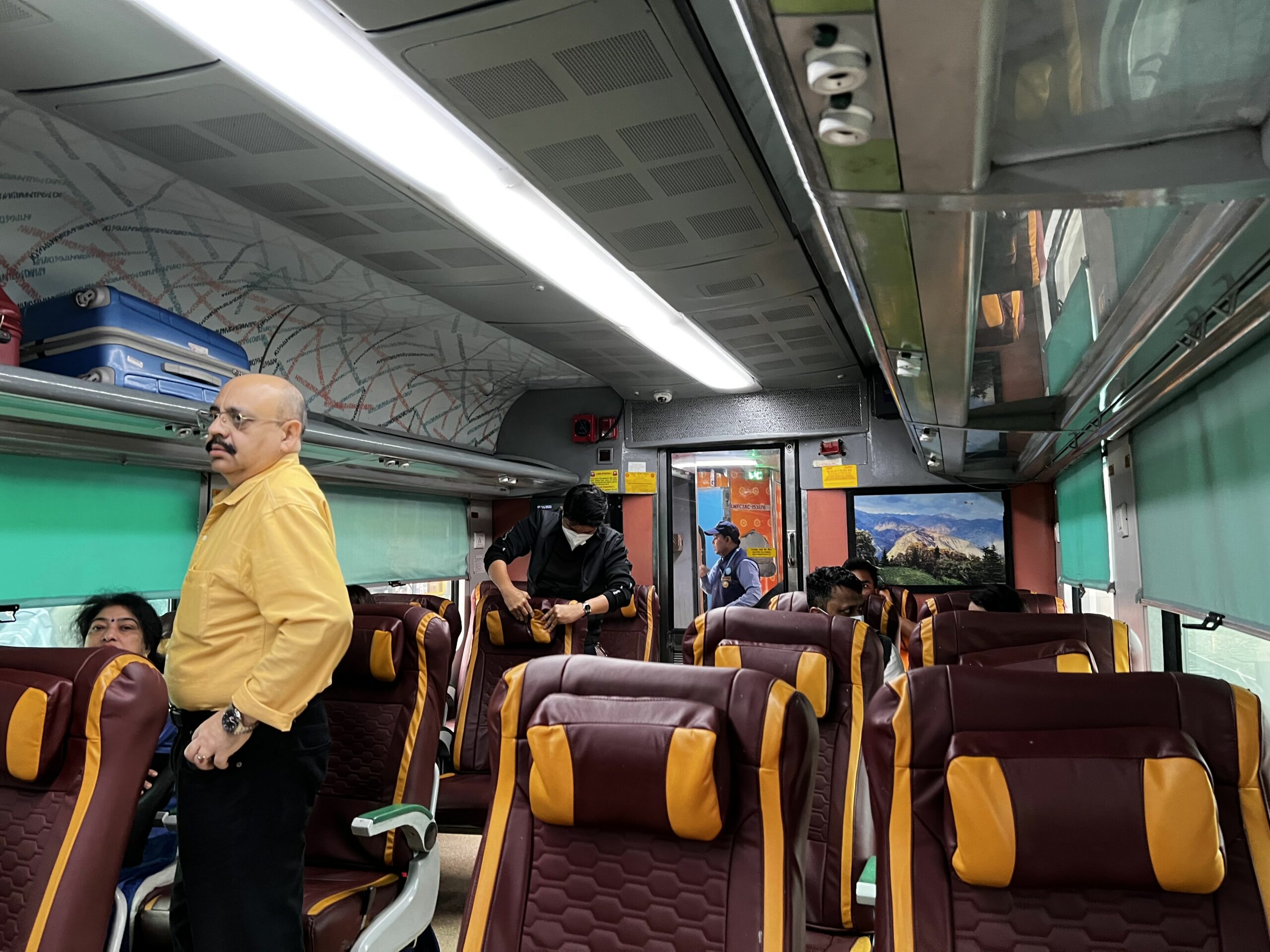
Budget: A costly option for reserved, non-sleeper classes. I paid INR 1496 ($17.96) for the same journey as the CC class that costs INR 755 ($9.07).
Comfort: Very comfortable, recliner seats, and slightly less crowded than the CC class. It’s like the business class of the local trains you may know from back home.
Includes: Food and AC.
Privacy: There isn’t much privacy, as it’s just an open space for shorter journeys.
Safety: Very safe.
Journey Duration: Suitable for shorter journeys between bigger cities.
Recommended for: Travelers that like to travel luxurious and comfortable, and have a bit of extra money to spend.
The Executive Chair Class is found on just a handful of trains. They are often premium, super-fast passenger trains that run between the big cities such as Delhi, Agra and Jaipur. It’s quite luxurious with good food, even on shorter journeys. It’s also costlier than all the other options. I went from Delhi to Agra with this class, and had to pay INR 1496 ($17.96) for a one hour and forty minutes train journey. You’d get a lot of leg space, overhead luggage storage, comfort and great food and facilities. If you’re looking for a bit of luxury for your shorter trips, this might be a great option for you.
Anubhuti Class
Budget: The costliest option for reserved, non-sleeper classes. I paid INR 2200 ($20+) to Amritsar from Delhi
Comfort: Very comfortable, reclining chairs with table for work, a lot of space and food served to you throughout the ride
Privacy: No privacy here
Safety: Very safe.
Journey Duration: Suitable for shorter journeys between bigger cities and business journeys
Recommended for: Travelers who like to travel luxuriously and comfortable, and have a bit of extra money to spend.

Anubhuti Class is a step above EC class and they just released this class in India in 2023. It’s a little bit better than EC class with more comfortable seats and hopes to provide a similar experience to flying in business class with an airline.
I took this train from Delhi to Amritsar and the service was fantastic. The seats are in a row of two and you get a lot of space for leg room, you can recline the chair and you get fed well. In my journey on this class I got 2 meals, which come with a main, a dessert, some kind of bread or something little to munch on and after they serve Chai tea with biscuits.
This is a class where mostly business executives travel in. You will meet a lot of India’s top talent and have some very interesting conversations with some high performers. I met food chemists, business owners and other interesting professions who I chatted to for hours about their work and what they do.
Sleeper Class (SL)
Budget: It’s the cheapest option you’d have for overnight journeys with a bed. A journey for ten hours would cost you approximately INR 325 ($3.90).
Comfort: It’s quite uncomfortable because it’s often overcrowded, there’s no AC which makes it very hot, and it’s very dirty (that includes the toilets).
Includes: Fans and a bed.
Privacy: Non-existent. There are no curtains, and being a foreigner in this class would attract a lot of stares.
Safety: It’s not very safe, stealing isn’t uncommon, and people from the general class often travel along, which can results in fights and arguments with other passengers.
Journey Duration: Could be chosen for longer journeys.
Recommended for: The adventurous kind of traveler, who would like to experience and see it for themselves.
This class used to be popular among India’s middle class, though, most of them now opt for the 3AC. This is because nowadays, you’d often find people from the General Class moving over to the Sleeper Class because they were unable to get confirmed tickets.
Besides the crowd, you’d also struggle to find a clean toilet. Even if it’s called the ‘sleeper’ class, it’d be nearly impossible to actually get some sleep due to all the noise, how dirty it is, and the heat or the cold. The carriages are divided into open-plan compartments with six beds. There are 3 berths on either side of the compartment. Throughout the day, the middle berth has to be folded down against the wall to allow passengers to sit on the lower beds. It’s not a guarantee that this does happen, though, which would mean that you might have to lie down for your entire journey.
There’s barely any privacy, so you can expect some stares as a foreigner travelling in this class. The carriage is ventilated with fans, and you’d have windows covered by bars to keep intruders away, as the windows are often left open. It’s incredibly cheap and might be fun for some to try out and experience. Keep in mind that stealing and other forms of petty theft aren’t uncommon here, and it’s definitely not as safe as the other options below.
Three Tier Air Conditioned Class (3A)
Budget: Still very affordable. For a train journey of around sixteen hours you’d pay approximately INR 2690 ($32.30).
Comfort: Much more comfortable compared to the Sleeper Class, as it’s well regulated and much less crowded, with a working air conditioning system in all compartments. However, the three berths stacked above one another can be uncomfortable for some, though it’s definitely manageable.
Includes: Food, bedding, AC, and towels.
Privacy: There isn’t much privacy due to the lack of curtains in most 3AC compartments. However, some of the better trains do offer curtains.
Safety: It’s relatively safe. Always keep an eye on your belongings, but you won’t be bothered much by other people.
Journey Duration: Good option for longer train journeys.
Recommended for: Travelers on a budget.
The 3A class is a significant upgrade from the Sleeper class. The compartments are similar to the sleeper class, meaning that when all the berths are open you’d still not be able to sit upright. Sometimes, there are no curtains, which means no privacy. What you do have, though, is a working AC compartment and windows with tinted glass instead of iron bars.
Most passengers travelling with 3AC also tend to keep to themselves, which makes it quieter compared to the Sleeper Class. It’s a great option for travelers on a budget, and much safer and cleaner than the Sleeper Class. You’d be provided with bedding, towels, and food.
Two Tier Air Conditioned Class (2AC)
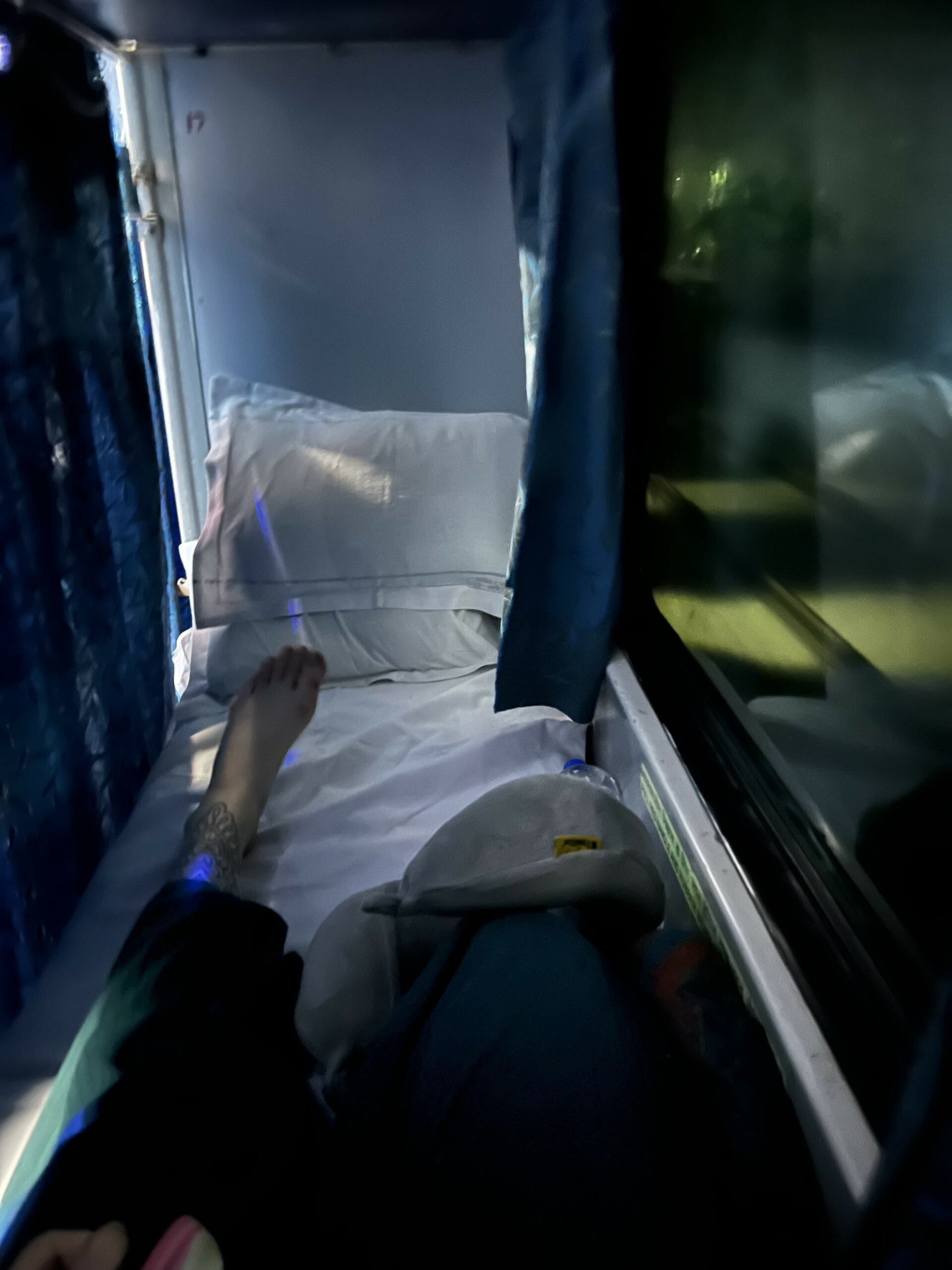
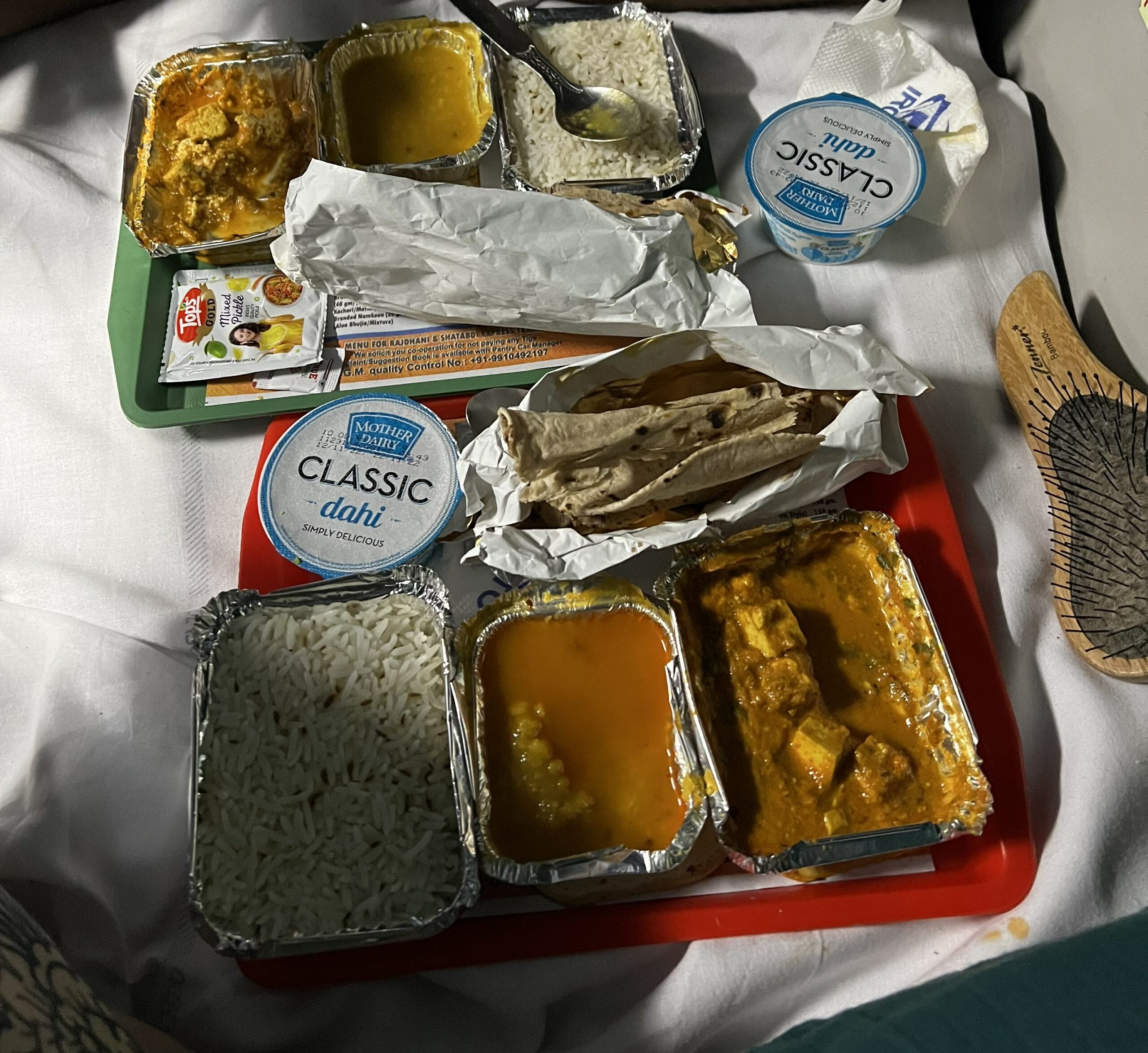
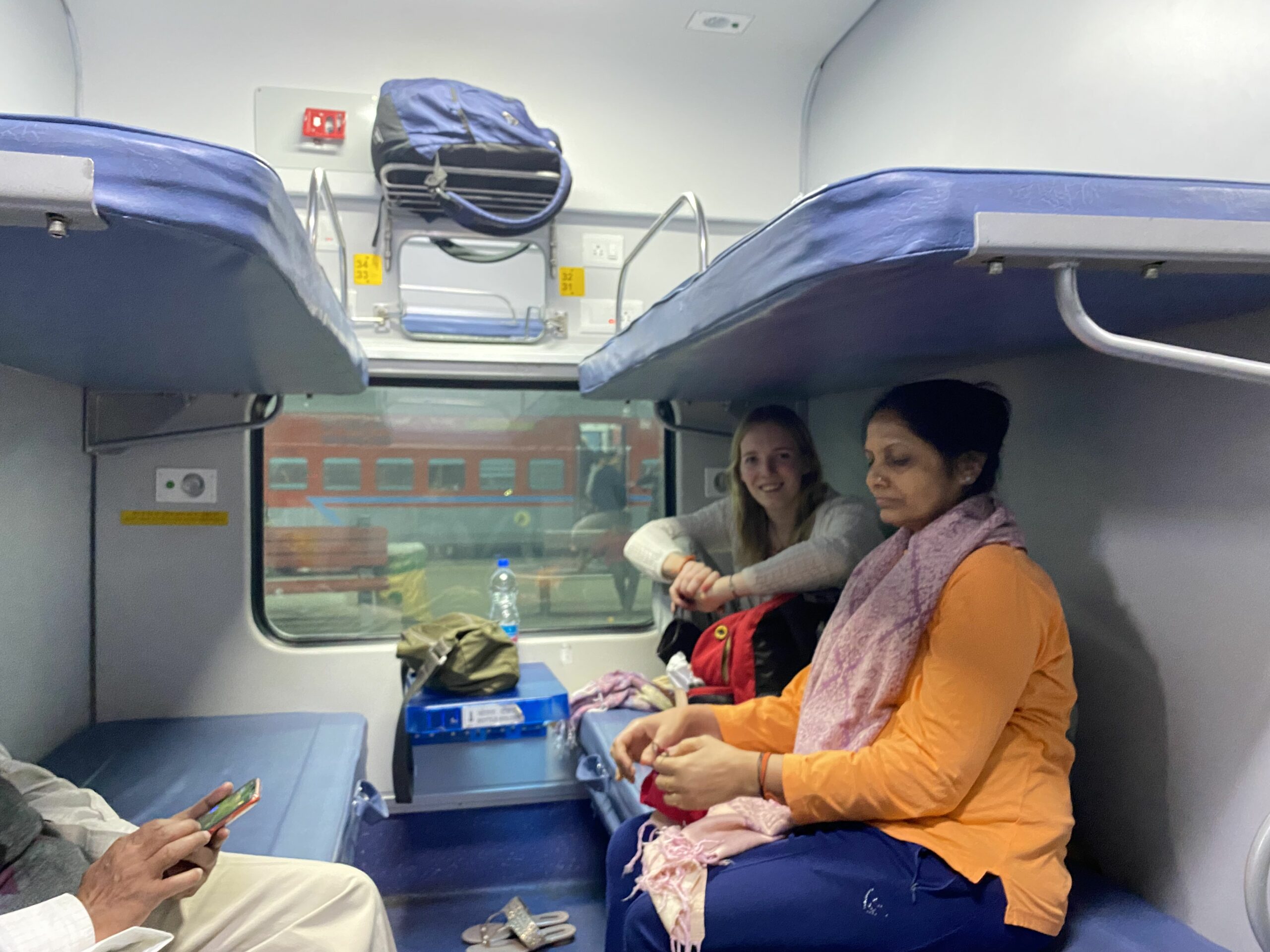
Budget: It’s a bit on the pricier side, especially compared to 3AC. For the same journey of sixteen hours, you’d pay around INR 3700 ($44.43).
Comfort: It’s incredibly comfortable, there’s much more space than the 3AC and there’s less people.
Includes: Food, bedding, towel, privacy curtains, AC, charging points (in some trains), and a reading light.
Privacy: There’s a lot of privacy, as most of the compartments have curtains.
Safety: It’s very safe, no one will bother you. Most people mind their own business in this class.
Journey Duration: Good option for long train journeys.
Recommended for: Travelers who would like more privacy and comfort and are okay with spending a bit more for it.
This class is my personal favourite, and I’ve travelled with 2AC class the most. It’s still affordable and more comfortable than the 3AC class, because there are only four beds in each compartment. The beds are stacked vertically in two berths on each side. Just like in all the other classes, there are also two berths along the aisle outside the compartments.
Besides the extra space and comfort you’d get, there are also curtains that add to your privacy. You’d get bedding, towels, and food. The 2AC also provides small reading lights and personal power plugs for its travelers. Both 2AC and 3AC are good for travelers, but I’d recommend 2AC for those that prefer a bit more comfort and privacy, with a bit more money to spend.
I went on a trip from Delhi to Guwahati, which was a 27-hour train journey on the 2AC class carriage. For the ticket, I paid INR 4465 ($53.62) and the catering costs were INR 675 ($8.11) for all the food provided: breakfast, lunch, and dinner for the entire duration of the journey.
First Class Air Conditioned (1AC)
Budget: Expensive, it’s often double the price of the 2AC class. Prices can be compared to flying. For a 27 hour train journey from Delhi to Guwahati you’d pay approximately INR 6445 ($77.39).
Comfort: The most comfortable you’d be on an Indian train. Everything is provided for, you’d even be able to take a shower.
Includes: An exclusive menu and special food, bedding, private washing basin, shower facilities, lockable doors, room freshener, and much more.
Privacy: The most privacy you’d get. You’ll have doors to your own compartment which can be locked.
Safety: As you essentially get a bedroom of your own, it’s incredibly safe. In some trains, there are even guards standing in front of the entrance to the 1AC class.
Journey Duration: Good option for long train journeys.
Recommended for: Travelers that value luxury and comfort over anything else, with a lot of extra money in their daily budget to allow for it.
The 1AC class is the most luxurious and expensive class offered by the Indian Railways. The prices are double compared to the 2AC class and are comparable to domestic fights. However, if you’re in search of luxury unlike any flight you’ve taken, this is it. With private compartments of two or four berths, lockable doors, a washbasin, and a mirror, it’s definitely worth the money if you’re up for it.
Bedding is, of course, included, along with the food. The menu is specifically designed for this class only, and unlike the other classes, you can customize it to your liking. The bathrooms are also very clean with shower cubicles. This is a great option for those that want to experience luxury while still travelling in a train through the vast and beautiful landscapes of India.
Best Trains To Travel By In India
As some of you might not know, India’s railway network is solely operated by the government. However, there are still different categories of trains that get a higher priority for service and maintenance than others.
Here are the best trains to travel by in India:
- Rajdhani Express – The best train to opt for.
It’s considered the best train category in India. It has the highest priority on the Indian Railway network, which ensures that delays are uncommon. It’s one of the fastest passenger trains operating in India. The services are the best compared to the other trains available, so if you can go for it, I’d definitely recommend opting for the Rajdhani over any other train available. I’ve also personally travelled with this one many times, and my experience with the Rajdhani category has always been comfortable.
- Shatadbi Express – A good choice for shorter journeys.
Shatabdi Express trains are fast passenger trains operated by the Indian Railways. They are day-trains and return to the station of origin the same day. So you wouldn’t often find them for longer journeys. The Shatabdi Expresses get the second highest priority after the Rajdhani, which makes it a good second option if it’s available for your travel route.
- Duronto Express – The fastest train option.
Duronto Express is a long-distance non-stop source to destination train. This train connects the several metros and major state capitals of India. It has one of the top priorities on the Indian Railways network, and delays are uncommon. It’s the fastest passenger train offered by the Indian Railways, however the facilities aren’t as top-notch as the Rajdhani.
Best Times Of Day To Travel
When taking local trains, it’s best to avoid the rush hour, as it can get incredibly crowded. Rush hour starts from 8:30 AM to 10:00 AM in the morning and 6:00 PM to 8:00 PM in the evening. It’s especially applicable in the case of Mumbai local trains, as it can be a real challenge to even get onto the train during these times. However, for longer train journeys, there is no best time of travel, as some of the classes – as mentioned above – would always be more crowded than the others, no matter what time of the day it is.
As a rule of thumb, traveling later at night or the very early hours of the morning are usually less busy. But the trains in India are the most popular form of transport and often all tickets are completely booked, making it hard to get seats at any hour.
Safety Tips on Trains in India
Petty crimes such as pickpocketing or theft aren’t very uncommon on trains in India. When you’re travelling by local trains, there are certain things you should keep in mind, and some precautions you could, or should, take to ensure your safety.
When travelling by sleeper trains, you won’t be able to keep an eye on your luggage 24/7. After all, they’re called sleeper trains for a reason. Getting a luggage chain is a great way to make sure that your backpack remains on your side, just weave the chain through a part of your backpack, put a lock on the zippers, and attach the chain under the berth. I personally travel with a small fanny pack, which stores my valuables such as my wallet, passport etc. and I always sleep with it.
Being a woman travelling in India, can definitely be scary when travelling alone by train.
Try and avoid taking trains that leave late in the evening or night, try to find a train which leaves when there is still some daylight. Always remember to dress modestly, which is also true for the rest of your time in India. Wear clothes that cover you well and aren’t revealing. There are waiting rooms at most train stations restricted for women, so make sure to make use of them whenever you want. Once you reach the train station, go to the information desk and ask whether this service is available on the station, and if so, where it’s located.
I’m sure you’d find some friendly aunties wanting to have a chat and make you feel way more comfortable while you’re passing your time there. If they aren’t available, look for some friendly-looking family and just sit near them. That’s how I’ve done most of my journeys, and always felt very safe as most people are helpful, friendly, and seem to look out for me.
Top note: when you buy one of the AC train tickets (3AC, 2AC, 1AC) you’ll have the right to use the general waiting rooms provided at the train station. This is much more comfortable, as the train station platforms can often be crowded, or feel a bit unsafe. The waiting room areas are well-lit, and there’s often enough space to sit comfortably and wait for your train to arrive.
Travelling With Special Conditions
Talking about accommodating special needs and making train travel accessible to everyone travelling in India, there has been a slew of good news in the past few years. According to current government policy, everyone – regardless of their abilities, ethnicity, nationality, or race – is free to use the railway system. Wheelchair-accessible coaches, designed with wider entrances and modified facilities, are now available on almost all Mail/Express trains.
Additionally, there’s a dedicated reservation quota for physically challenged passengers, along with discounted prices. While India may not have station guides like most Western countries, Railway Protection Force (RPF) personnel are trained to assist physically disabled passengers and provide help to those who need it.
Cultural Etiquette on Trains in India
Going on a train journey in India isn’t only about reaching your destination – it’s also about the experience of the ride itself. To ensure a pleasant and great experience with some of the fellow passengers you might interact with, here are some do’s and don’ts while doing so:
Do’s and Don’ts while interacting with others on the train:
- Do strike up a friendly conversation
- Do share your food
- Do take off your shoes while seated
- Do eat or give handshakes with the right hand
- Don’t be too loud
- Don’t play things on your phone without using headphones
- Don’t wear revealing clothes
- Don’t use your left hand for eating or giving handshakes
Another golden rule: patience is key, it’s India and some trains may run on India’s unique clock.
Comparison with Other Modes of Travel
To travel between destinations, there are three modes of transport that you can essentially choose:
- Buses are the best when it comes to shorter distances and places without direct train connections.
- Trains are the best for long distances, but can also be used for shorter distances if the train connection is available.
- Flights are the best if you don’t want to travel for 10+ hours when going to a place afar and don’t mind spending more money on it.
- Additionally, coastal regions have the option of ferries and water transport, depending on the distances traveled, though this can be a slower option than all the other ones.
Booking Tickets
You can book train tickets through these websites:
- The Indian Railways Official website (IRCTC account required & possible for foreigners)
- 12goasia (Best option for travelers)
- MakeMyTrip
- Redbus

Jytte is a 22-year-old female adventurer from The Netherlands. She loves to fully immerse herself in the local ways of living, going ‘off the beaten path’ to truly experience the countries she visits and their unique way of life. Her wanderlust has taken her to Asia, with a particular focus on India. Here you’ll find her writing about all things India and Asia with a focus on digital nomadding there.
